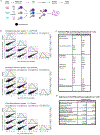Distinct proteostasis circuits cooperate in nuclear and cytoplasmic protein quality control
- PMID: 30429547
- PMCID: PMC6707801
- DOI: 10.1038/s41586-018-0678-x
Distinct proteostasis circuits cooperate in nuclear and cytoplasmic protein quality control
Abstract
Protein misfolding is linked to a wide array of human disorders, including Alzheimer's disease, Parkinson's disease and type II diabetes1,2. Protective cellular protein quality control (PQC) mechanisms have evolved to selectively recognize misfolded proteins and limit their toxic effects3-9, thus contributing to the maintenance of the proteome (proteostasis). Here we examine how molecular chaperones and the ubiquitin-proteasome system cooperate to recognize and promote the clearance of soluble misfolded proteins. Using a panel of PQC substrates with distinct characteristics and localizations, we define distinct chaperone and ubiquitination circuitries that execute quality control in the cytoplasm and nucleus. In the cytoplasm, proteasomal degradation of misfolded proteins requires tagging with mixed lysine 48 (K48)- and lysine 11 (K11)-linked ubiquitin chains. A distinct combination of E3 ubiquitin ligases and specific chaperones is required to achieve each type of linkage-specific ubiquitination. In the nucleus, however, proteasomal degradation of misfolded proteins requires only K48-linked ubiquitin chains, and is thus independent of K11-specific ligases and chaperones. The distinct ubiquitin codes for nuclear and cytoplasmic PQC appear to be linked to the function of the ubiquilin protein Dsk2, which is specifically required to clear nuclear misfolded proteins. Our work defines the principles of cytoplasmic and nuclear PQC as distinct, involving combinatorial recognition by defined sets of cooperating chaperones and E3 ligases. A better understanding of how these organelle-specific PQC requirements implement proteome integrity has implications for our understanding of diseases linked to impaired protein clearance and proteostasis dysfunction.
Figures











Similar articles
-
The extent of Ssa1/Ssa2 Hsp70 chaperone involvement in nuclear protein quality control degradation varies with the substrate.Mol Biol Cell. 2020 Feb 1;31(3):221-233. doi: 10.1091/mbc.E18-02-0121. Epub 2019 Dec 11. Mol Biol Cell. 2020. PMID: 31825716 Free PMC article.
-
Exposed hydrophobicity is a key determinant of nuclear quality control degradation.Mol Biol Cell. 2011 Jul 1;22(13):2384-95. doi: 10.1091/mbc.E11-03-0256. Epub 2011 May 5. Mol Biol Cell. 2011. PMID: 21551067 Free PMC article.
-
Nuclear Ubiquitin-Proteasome Pathways in Proteostasis Maintenance.Biomolecules. 2021 Jan 4;11(1):54. doi: 10.3390/biom11010054. Biomolecules. 2021. PMID: 33406777 Free PMC article. Review.
-
Ubiquitin Ligase Redundancy and Nuclear-Cytoplasmic Localization in Yeast Protein Quality Control.Biomolecules. 2021 Dec 3;11(12):1821. doi: 10.3390/biom11121821. Biomolecules. 2021. PMID: 34944465 Free PMC article. Review.
-
Hsp70 targets a cytoplasmic quality control substrate to the San1p ubiquitin ligase.J Biol Chem. 2013 Jun 21;288(25):18506-20. doi: 10.1074/jbc.M113.475905. Epub 2013 May 7. J Biol Chem. 2013. PMID: 23653356 Free PMC article.
Cited by
-
TTC3-Mediated Protein Quality Control, A Potential Mechanism for Cognitive Impairment.Cell Mol Neurobiol. 2022 Aug;42(6):1659-1669. doi: 10.1007/s10571-021-01060-z. Epub 2021 Feb 27. Cell Mol Neurobiol. 2022. PMID: 33638766 Free PMC article. Review.
-
The role of ubiquitination in health and disease.MedComm (2020). 2024 Sep 25;5(10):e736. doi: 10.1002/mco2.736. eCollection 2024 Oct. MedComm (2020). 2024. PMID: 39329019 Free PMC article. Review.
-
MitoStores: chaperone-controlled protein granules store mitochondrial precursors in the cytosol.EMBO J. 2023 Apr 3;42(7):e112309. doi: 10.15252/embj.2022112309. Epub 2023 Jan 27. EMBO J. 2023. PMID: 36704946 Free PMC article.
-
Dynamic Regulation of the 26S Proteasome: From Synthesis to Degradation.Front Mol Biosci. 2019 Jun 7;6:40. doi: 10.3389/fmolb.2019.00040. eCollection 2019. Front Mol Biosci. 2019. PMID: 31231659 Free PMC article. Review.
-
Nuclear ubiquitination permits Hippo-YAP signal for liver development and tumorigenesis.Nat Chem Biol. 2025 May 16. doi: 10.1038/s41589-025-01901-8. Online ahead of print. Nat Chem Biol. 2025. PMID: 40379800
References
Publication types
MeSH terms
Substances
Grants and funding
LinkOut - more resources
Full Text Sources
Molecular Biology Databases
Research Materials

